Individual Tree Aboveground Biomass Estimation Based on UAV Stereo Images in a Eucalyptus Plantation
Abstract
:1. Introduction
2. Materials and Methods
2.1. Study Area
2.2. Data Introduction
2.2.1. Field Data
2.2.2. UAV Stereo Images
2.3. Method
2.3.1. AGB Calculation of Individual Eucalyptus Trees
2.3.2. UAV Stereo Image Processing
2.3.3. Individual Eucalyptus Tree Segmentation Method
2.3.4. Features Extraction
- (1)
- Individual Tree Crown Area and TH
- (2)
- Spectral Reflectance and Vegetation Index
- (3)
- Texture Features
2.3.5. Feature Combination and Feature Optimization
2.3.6. AGB Estimation Model Construction Algorithms
- (1)
- Ridge regression
- (2)
- Random forest
- (3)
- CatBoost
2.3.7. Accuracy Evaluation
3. Result and Analysis
3.1. Individual Tree Segmentation Results for the Eucalyptus Plantations
3.2. Extraction Results for Individual Tree Crown Areas and TH
3.3. Correlation Analysis Results between Features and AGB
3.4. AGB Estimation Results for Individual Eucalyptus Trees Based on Different Feature Combinations
3.5. AGB Estimation Results for Individual Eucalyptus Trees Based on Feature Optimization
3.6. Spatial Distribution Results for Individual Tree AGB in Eucalyptus Plantations Based on the Optimal Estimation Model
4. Discussion
4.1. Analysis of Different Feature Variables in Eucalyptus AGB Estimation
4.2. Analysis of Different Algorithms on Eucalyptus AGB Estimation
5. Conclusions
- (1)
- The impact of different features on estimating the AGB of individual eucalyptus trees varies, with TH having the greatest impact, followed by forest age, with texture, crown area, spectral reflectance, and vegetation index having relatively small effects.
- (2)
- Of the three algorithms, the model established with CatBoost had the highest accuracy, with an R2 ranging from 0.65 to 0.90, an NRMSE ranging from 0.08 to 0.15, and a Bias ranging from −0.39 to 0.01, followed by the random forest algorithm, with an R2 ranging from 0.59 to 0.88, an NRMSE ranging from 0.09 to 0.16, and a Bias ranging from −0.82 to −0.19. The ridge regression algorithm had the lowest accuracy, with an R2 ranging from 0.34 to 0.82, an NRMSE ranging from 0.11 to 0.21, and a Bias ranging from −0.07 to 0.03.
- (3)
- Accurately estimating the AGB of individual eucalyptus trees can be achieved based on UAV stereo images. The model constructed with TH, forest age, crown area, and HOM-B feature variables using the CatBoost algorithm had the best estimation accuracy, with an R2 of 0.90 and an NRMSE of 0.08.
Author Contributions
Funding
Data Availability Statement
Acknowledgments
Conflicts of Interest
References
- Schönau, A. Silvicultural considerations for high productivity of Eucalyptus grandis. For. Ecol. Manag. 1984, 9, 295–314. [Google Scholar] [CrossRef]
- Silverio, F.O.; Barbosa, L.C.A.; Maltha, C.R.A.; Silvestre, A.J.D.; Pilo-Veloso, D.; Gomide, J.L. Characterization of lipophilic wood extractives from clones of Eucalyptus urograndis cultivate in Brazil. BioResources 2007, 2, 157–168. [Google Scholar] [CrossRef]
- González-García, M.; Hevia, A.; Majada, J.; De Anta, R.C.; Barrio-Anta, M. Dynamic growth and yield model including environmental factors for Eucalyptus nitens (Deane & Maiden) Maiden short rotation woody crops in Northwest Spain. New For. 2015, 46, 387–407. [Google Scholar] [CrossRef]
- Boisvenue, C.; Smiley, B.P.; White, J.C.; Kurz, W.A.; Wulder, M.A. Integration of Landsat time series and field plots for forest productivity estimates in decision support models. For. Ecol. Manag. 2016, 376, 284–297. [Google Scholar] [CrossRef]
- Nevalainen, O.; Honkavaara, E.; Tuominen, S.; Viljanen, N.; Hakala, T.; Yu, X.; Hyyppä, J.; Saari, H.; Pölönen, I.; Imai, N.N.; et al. Individual Tree Detection and Classification with UAV-Based Photogrammetric Point Clouds and Hyperspectral Imaging. Remote Sens. 2017, 9, 185. [Google Scholar] [CrossRef]
- Kumbula, S.T.; Mafongoya, P.; Peerbhay, K.Y.; Lottering, R.T.; Ismail, R. Using Sentinel-2 Multispectral Images to Map the Occurrence of the Cossid Moth (Coryphodema tristis) in Eucalyptus Nitens Plantations of Mpumalanga, South Africa. Remote Sens. 2019, 11, 278. [Google Scholar] [CrossRef]
- Verma, N.K.; Lamb, D.W.; Sinha, P. Airborne LiDAR and high resolution multispectral data integration in Eucalyptus tree species mapping in an Australian farmscape. Geocarto Int. 2022, 37, 70–90. [Google Scholar] [CrossRef]
- Berra, E.F.; Brandelero, C.; Pereira, R.S.; Sebem, E.; Goergen, L.C.d.G.; Benedetti, A.C.P.; Lippert, D.B. Total wood volume estimation of Eucalyptus species by images of landsat satellite. Ciênc. Florest. 2012, 22, 853–864. [Google Scholar] [CrossRef]
- Gebreslasie, M.; Ahmed, F.; Van Aardt, J.A. Extracting structural attributes from IKONOS imagery for Eucalyptus plantation forests in KwaZulu-Natal, South Africa, using image texture analysis and artificial neural networks. Int. J. Remote Sens. 2011, 32, 7677–7701. [Google Scholar] [CrossRef]
- Johansen, K.; Raharjo, T.; McCabe, M.F. Using Multi-Spectral UAV Imagery to Extract Tree Crop Structural Properties and Assess Pruning Effects. Remote Sens. 2018, 10, 854. [Google Scholar] [CrossRef]
- Yang, K.; Zhang, H.; Wang, F.; Lai, R. Extraction of Broad-Leaved Tree Crown Based on UAV Visible Images and OBIA-RF Model: A Case Study for Chinese Olive Trees. Remote Sens. 2022, 14, 2469. [Google Scholar] [CrossRef]
- Latifah, S.; Teodoro, R.; Myrna, G.; Nathaniel, C.; Leonardo, M. Predicted Stand Volume for Eucalyptus Plantations by Spatial Analysis. In IOP Conference Series: Earth and Environmental Science; IOP Publishing: Bristol, UK, 2018; p. 012117. [Google Scholar]
- Tompalski, P.; Coops, N.C.; Marshall, P.L.; White, J.C.; Wulder, M.A.; Bailey, T. Combining multi-date airborne laser scanning and digital aerial photogrammetric data for forest growth and yield modelling. Remote Sens. 2018, 10, 347. [Google Scholar] [CrossRef]
- De Moura, Y.M.; Balzter, H.; Galvão, L.S.; Dalagnol, R.; Espírito-Santo, F.; Santos, E.G.; Garcia, M.; Bispo, P.d.C.; Oliveira, R.C.; Shimabukuro, Y.E. Carbon Dynamics in a Human-Modified Tropical Forest: A Case Study Using Multi-Temporal LiDAR Data. Remote Sens. 2020, 12, 430. [Google Scholar] [CrossRef]
- You, H.; Liu, Y.; Lei, P.; Qin, Z.; You, Q. Segmentation of individual mangrove trees using UAV-based LiDAR data. Ecol. Informatics 2023, 77, 102200. [Google Scholar] [CrossRef]
- Chan, E.P.Y.; Fung, T.; Wong, F.K.K. Estimating above-ground biomass of subtropical forest using airborne LiDAR in Hong Kong. Sci. Rep. 2021, 11, 1751. [Google Scholar] [CrossRef] [PubMed]
- Fatoyinbo, T.; Feliciano, E.A.; Lagomasino, D.; Lee, S.K.; Trettin, C. Estimating mangrove aboveground biomass from airborne LiDAR data: A case study from the Zambezi River delta. Environ. Res. Lett. 2018, 13, 025012. [Google Scholar] [CrossRef]
- Jaakkola, A.; Hyyppä, J.; Yu, X.; Kukko, A.; Kaartinen, H.; Liang, X.; Hyyppä, H.; Wang, Y. Autonomous Collection of Forest Field Reference—The Outlook and a First Step with UAV Laser Scanning. Remote Sens. 2017, 9, 785. [Google Scholar] [CrossRef]
- Fan, Y.; Feng, H.; Jin, X.; Yue, J.; Liu, Y.; Li, Z.; Feng, Z.; Song, X.; Yang, G. Estimation of the nitrogen content of potato plants based on morphological parameters and visible light vegetation indices. Front. Plant Sci. 2022, 13, 1012070. [Google Scholar] [CrossRef]
- Tang, X.; You, H.; Liu, Y.; You, Q.; Chen, J. Monitoring of Monthly Height Growth of Individual Trees in a Subtropical Mixed Plantation Using UAV Data. Remote Sens. 2023, 15, 326. [Google Scholar] [CrossRef]
- Chen, J.; Chen, Z.; Huang, R.; You, H.; Han, X.; Yue, T.; Zhou, G. The Effects of Spatial Resolution and Resampling on the Classification Accuracy of Wetland Vegetation Species and Ground Objects: A Study Based on High Spatial Resolution UAV Images. Drones 2023, 7, 61. [Google Scholar] [CrossRef]
- Iglhaut, J.; Cabo, C.; Puliti, S.; Piermattei, L.; O’Connor, J.; Rosette, J. Structure from Motion Photogrammetry in Forestry: A Review. Curr. For. Rep. 2019, 5, 155–168. [Google Scholar] [CrossRef]
- Zarco-Tejada, P.J.; Diaz-Varela, R.; Angileri, V.; Loudjani, P. Tree height quantification using very high resolution imagery acquired from an unmanned aerial vehicle (UAV) and automatic 3D photo-reconstruction methods. Eur. J. Agron. 2014, 55, 89–99. [Google Scholar] [CrossRef]
- Navarro, J.A.; Algeet, N.; Fernández-Landa, A.; Esteban, J.; Rodríguez-Noriega, P.; Guillén-Climent, M.L. Integration of UAV, Sentinel-1, and Sentinel-2 Data for Mangrove Plantation Aboveground Biomass Monitoring in Senegal. Remote Sens. 2019, 11, 77. [Google Scholar] [CrossRef]
- You, H.; Tang, X.; You, Q.; Liu, Y.; Chen, J.; Wang, F. Study on the Differences between the Extraction Results of the Structural Parameters of Individual Trees for Different Tree Species Based on UAV LiDAR and High-Resolution RGB Images. Drones 2023, 7, 317. [Google Scholar] [CrossRef]
- Alonzo, M.; Dial, R.J.; Schulz, B.K.; Andersen, H.-E.; Lewis-Clark, E.; Cook, B.D.; Morton, D.C. Mapping tall shrub biomass in Alaska at landscape scale using structure-from-motion photogrammetry and lidar. Remote Sens. Environ. 2020, 245, 111841. [Google Scholar] [CrossRef]
- Guerra-Hernández, J.; Cosenza, D.N.; Rodriguez, L.C.E.; Silva, M.; Tomé, M.; Díaz-Varela, R.A.; González-Ferreiro, E. Comparison of ALS-and UAV (SfM)-derived high-density point clouds for individual tree detection in Eucalyptus plantations. Int. J. Remote Sens. 2018, 39, 5211–5235. [Google Scholar] [CrossRef]
- Guerra-Hernández, J.; Cosenza, D.N.; Cardil, A.; Silva, C.A.; Botequim, B.; Soares, P.; Silva, M.; González-Ferreiro, E.; Díaz-Varela, R.A. Predicting Growing Stock Volume of Eucalyptus Plantations Using 3-D Point Clouds Derived from UAV Imagery and ALS Data. Forests 2019, 10, 905. [Google Scholar] [CrossRef]
- Dang, A.T.N.; Nandy, S.; Srinet, R.; Luong, N.V.; Ghosh, S.; Kumar, A.S. Forest aboveground biomass estimation using machine learning regression algorithm in Yok Don National Park, Vietnam. Ecol. Inform. 2019, 50, 24–32. [Google Scholar] [CrossRef]
- Montesano, P.; Cook, B.; Sun, G.; Simard, M.; Nelson, R.; Ranson, K.; Zhang, Z.; Luthcke, S. Achieving accuracy requirements for forest biomass mapping: A spaceborne data fusion method for estimating forest biomass and LiDAR sampling error. Remote Sens. Environ. 2013, 130, 153–170. [Google Scholar] [CrossRef]
- Gomez, C.; Mangeas, M.; Petit, M.; Corbane, C.; Hamon, P.; Hamon, S.; De Kochko, A.; Le Pierres, D.; Poncet, V.; Despinoy, M. Use of high-resolution satellite imagery in an integrated model to predict the distribution of shade coffee tree hybrid zones. Remote Sens. Environ. 2010, 114, 2731–2744. [Google Scholar] [CrossRef]
- Selvaraj, M.G.; Vergara, A.; Montenegro, F.; Ruiz, H.A.; Safari, N.; Raymaekers, D.; Ocimatie, W.; Ntamwirac, J.; Titsd, L.; Blomme, G.; et al. Detection of banana plants and their major diseases through aerial images and machine learning methods: A case study in DR Congo and Republic of Benin. ISPRS J. Photogramm. Remote Sens. 2020, 169, 110–124. [Google Scholar] [CrossRef]
- Zhang, Y.; Ma, J.; Liang, S.; Li, X.; Li, M. An Evaluation of Eight Machine Learning Regression Algorithms for Forest Aboveground Biomass Estimation from Multiple Satellite Data Products. Remote Sens. 2020, 12, 4015. [Google Scholar] [CrossRef]
- LY/T 2253-2014; Guidelines for Carbon Sink Measurement and Monitoring for Afforestation Projects. SAMR: Beijing, China, 2014.
- Qi, C.R.; Yi, L.; Su, H.; Guibas, L.J. Pointnet++: Deep Hierarchical Feature Learning on Point Sets in a Metric Space. In Advances in Neural Information Processing Systems; MIT Press: Cambridge, MA, USA, 2017; Volume 30. [Google Scholar]
- Gitelson, A.A.; Kaufman, Y.J.; Stark, R.; Rundquist, D. Novel algorithms for remote estimation of vegetation fraction. Remote Sens. Environ. 2002, 80, 76–87. [Google Scholar] [CrossRef]
- Meyer, G.E.; Neto, J.C. Verification of color vegetation indices for automated crop imaging applications. Comput. Electron. Agric. 2008, 63, 282–293. [Google Scholar] [CrossRef]
- Guijarro, M.; Pajares, G.; Riomoros, I.; Herrera, P.; Burgos-Artizzu, X.; Ribeiro, A. Automatic segmentation of relevant textures in agricultural images. Comput. Electron. Agric. 2011, 75, 75–83. [Google Scholar] [CrossRef]
- Woebbecke, D.M.; Meyer, G.E.; Von Bargen, K.; Mortensen, D.A. Color Indices for Weed Identification Under Various Soil, Residue, and Lighting Conditions. Trans. ASAE 1995, 38, 259–269. [Google Scholar] [CrossRef]
- Kawashima, S.; Nakatani, M. An Algorithm for Estimating Chlorophyll Content in Leaves Using a Video Camera. Ann. Bot. 1998, 81, 49–54. [Google Scholar] [CrossRef]
- Louhaichi, M.; Borman, M.M.; Johnson, D.E. Spatially Located Platform and Aerial Photography for Documentation of Grazing Impacts on Wheat. Geocarto Int. 2001, 16, 65–70. [Google Scholar] [CrossRef]
- Hague, T.; Tillett, N.D.; Wheeler, H. Automated Crop and Weed Monitoring in Widely Spaced Cereals. Precis. Agric. 2006, 7, 21–32. [Google Scholar] [CrossRef]
- Bendig, J.; Yu, K.; Aasen, H.; Bolten, A.; Bennertz, S.; Broscheit, J.; Gnyp, M.L.; Bareth, G. Combining UAV-based plant height from crop surface models, visible, and near infrared vegetation indices for biomass monitoring in barley. Int. J. Appl. Earth Obs. Geoinf. 2015, 39, 79–87. [Google Scholar] [CrossRef]
- Liang, Y.; Kou, W.; Lai, H.; Wang, J.; Wang, Q.; Xu, W.; Wang, H.; Lu, N. Improved estimation of aboveground biomass in rubber plantations by fusing spectral and textural information from UAV-based RGB imagery. Ecol. Indic. 2022, 142, 109286. [Google Scholar] [CrossRef]
- Hoerl, A.E.; Kennard, R.W. Ridge regression: Biased estimation for nonorthogonal problems. Technometrics 1970, 12, 55–67. [Google Scholar] [CrossRef]
- Shih, S.F.; Gervin, J.C. Ridge Regression Techniques Applied to Landsat Investigation of Water Quality in Lake Okeechobee. JAWRA J. Am. Water Resour. Assoc. 1980, 16, 790–796. [Google Scholar] [CrossRef]
- Breiman, L. Random forests. Mach. Learn. 2001, 45, 5–32. [Google Scholar] [CrossRef]
- Prokhorenkova, L.; Gusev, G.; Vorobev, A.; Dorogush, A.V.; Gulin, A. CatBoost: Unbiased Boosting with Categorical Features. In Advances in Neural Information Processing Systems; MIT Press: Cambridge, MA, USA, 2018; Volume 31. [Google Scholar]
- Gao, L.; Chai, G.; Zhang, X. Above-Ground Biomass Estimation of Plantation with Different Tree Species Using Airborne LiDAR and Hyperspectral Data. Remote Sens. 2022, 14, 2568. [Google Scholar] [CrossRef]
- Zhao, Y.; Liu, X.; Wang, Y.; Zheng, Z.; Zheng, S.; Zhao, D.; Bai, Y. UAV-based individual shrub aboveground biomass estimation calibrated against terrestrial LiDAR in a shrub-encroached grassland. Int. J. Appl. Earth Obs. Geoinf. 2021, 101, 102358. [Google Scholar] [CrossRef]
- Dos Reis, A.A.; Franklin, S.E.; de Mello, J.M.; Junior, F.W.A. Volume estimation in a Eucalyptus plantation using multi-source remote sensing and digital terrain data: A case study in Minas Gerais State, Brazil. Int. J. Remote Sens. 2019, 40, 2683–2702. [Google Scholar] [CrossRef]
- Zheng, G.; Chen, J.; Tian, Q.; Ju, W.; Xia, X. Combining remote sensing imagery and forest age inventory for biomass mapping. J. Environ. Manag. 2007, 85, 616–623. [Google Scholar] [CrossRef]
- Ye, Q.; Yu, S.; Liu, J.; Zhao, Q.; Zhao, Z. Aboveground biomass estimation of black locust planted forests with aspect variable using machine learning regression algorithms. Ecol. Indic. 2021, 129, 107948. [Google Scholar] [CrossRef]
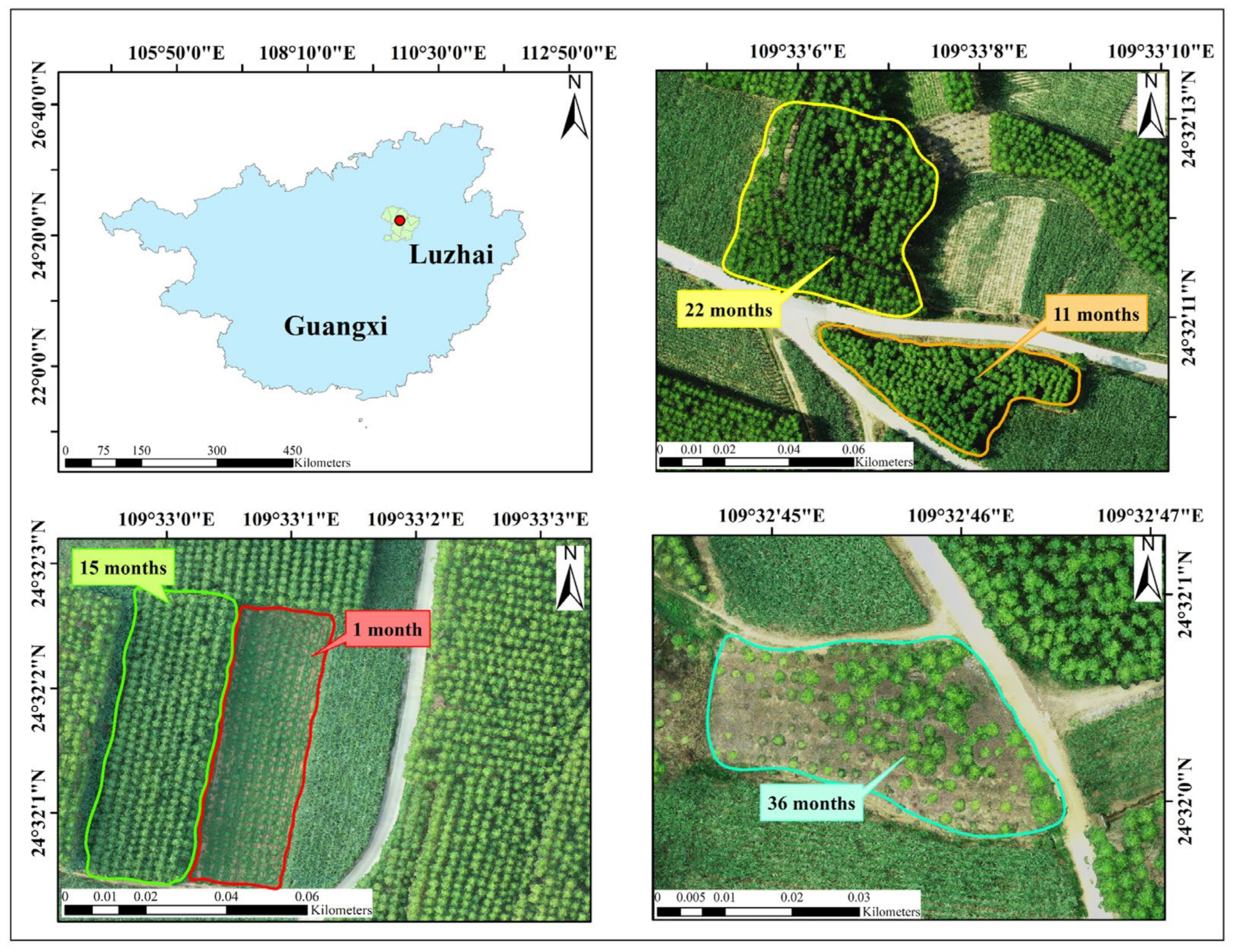
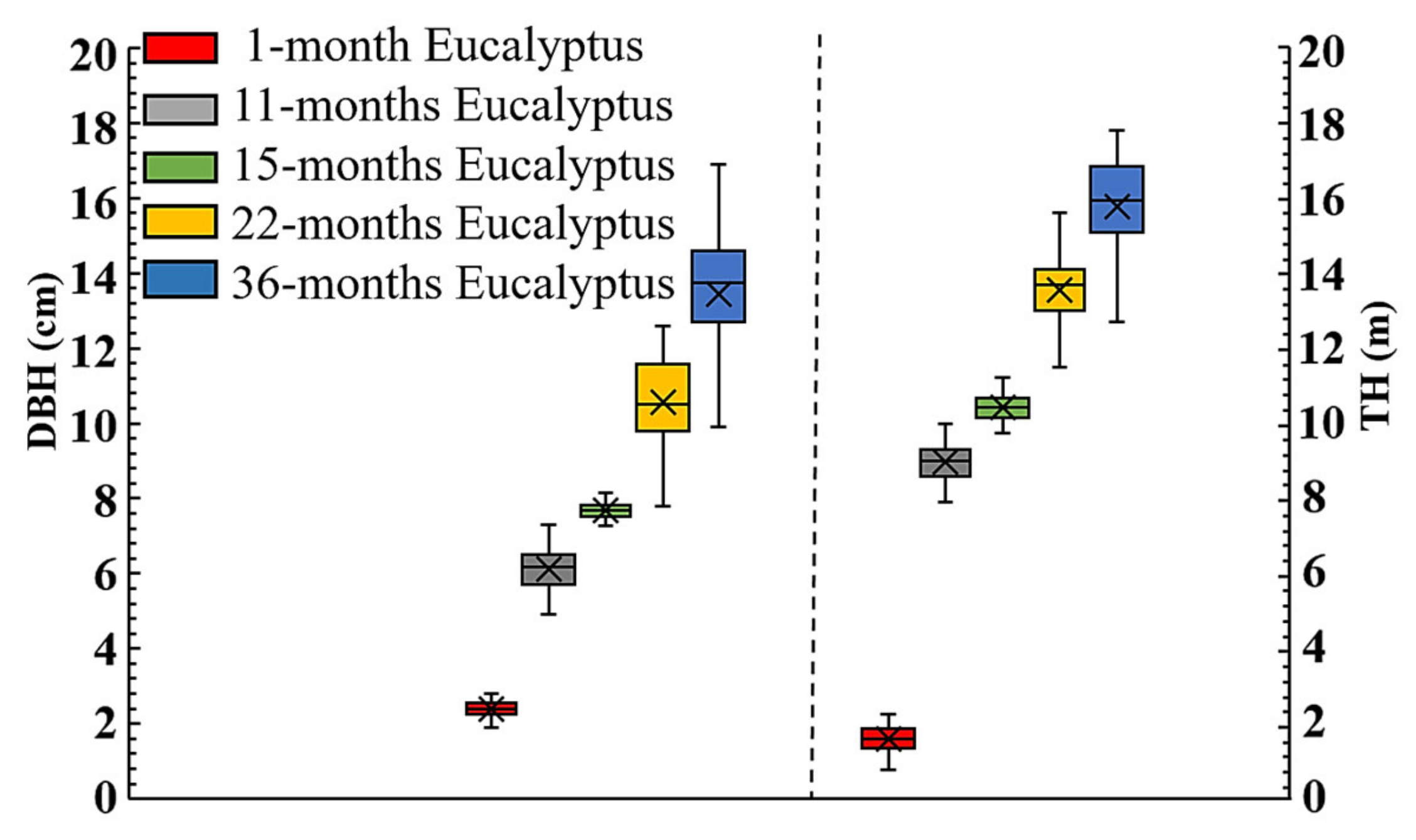
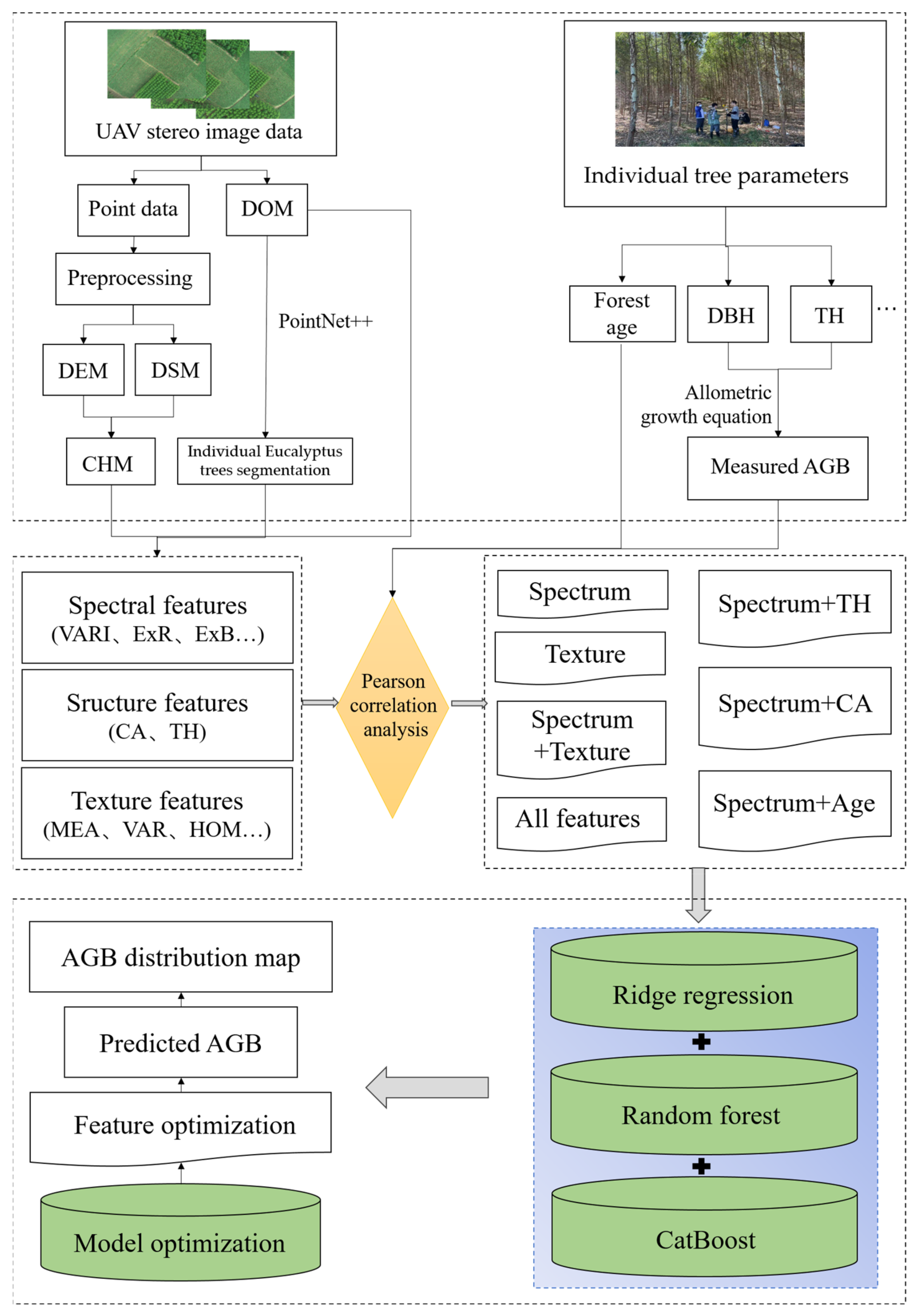

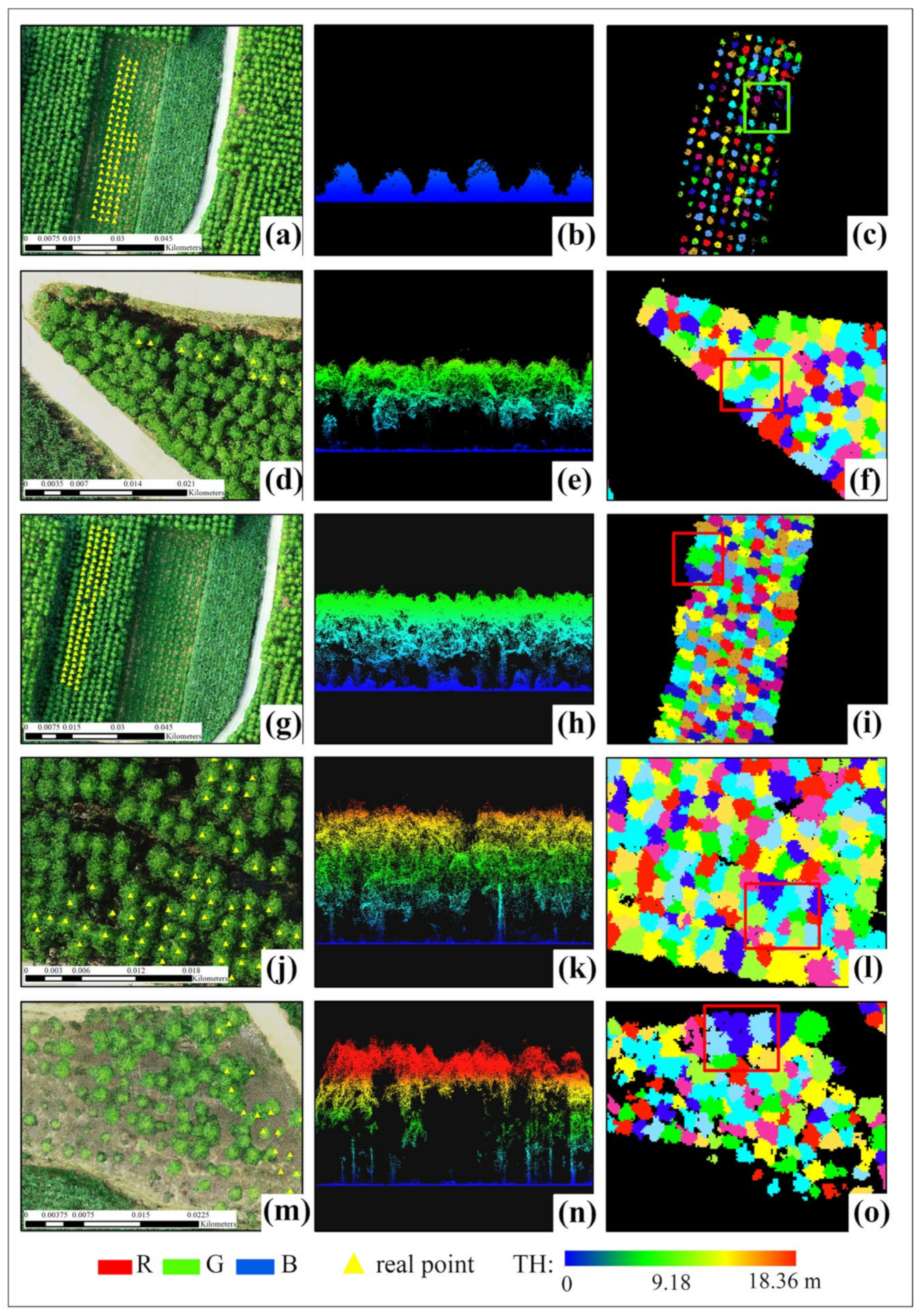
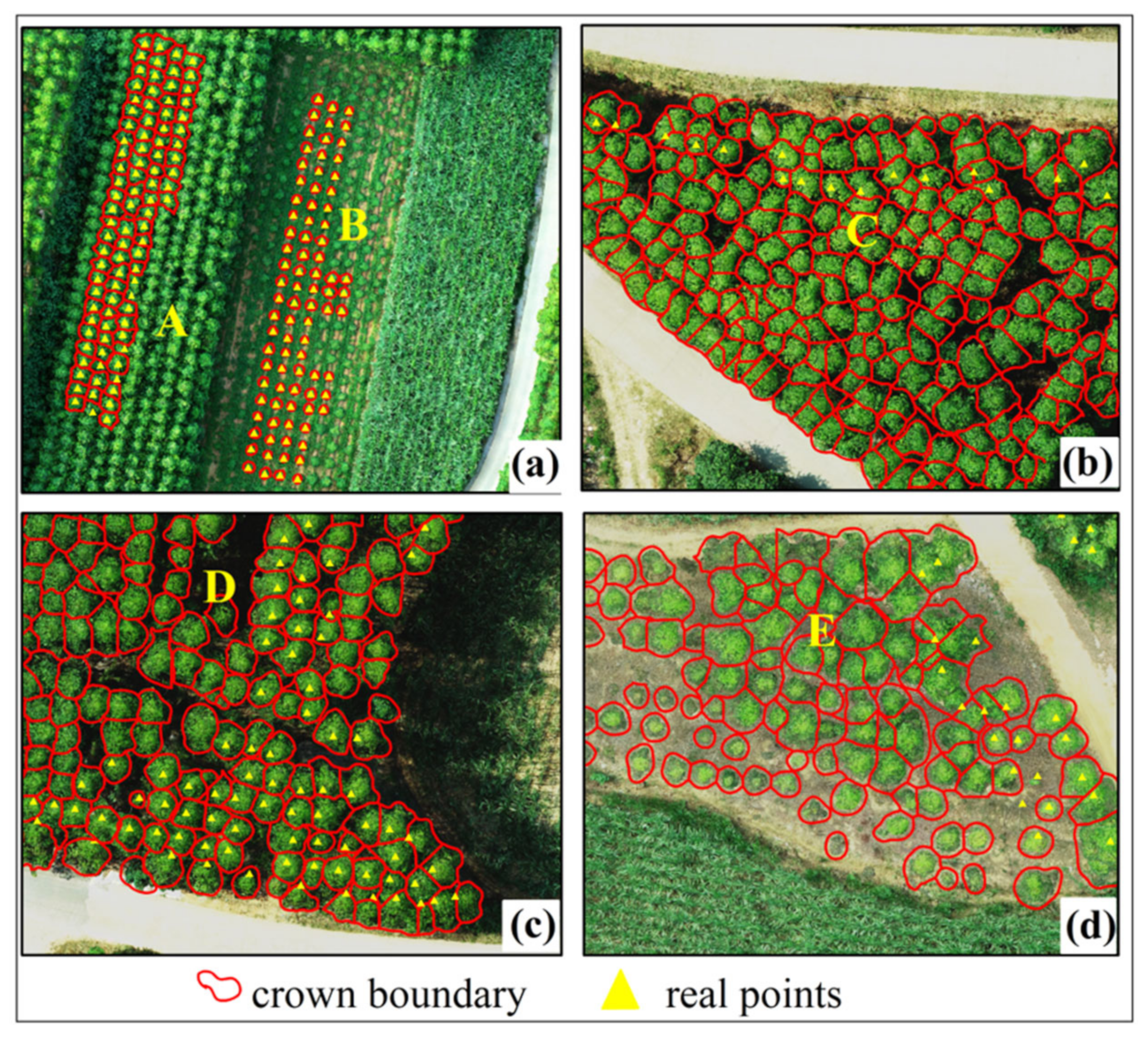


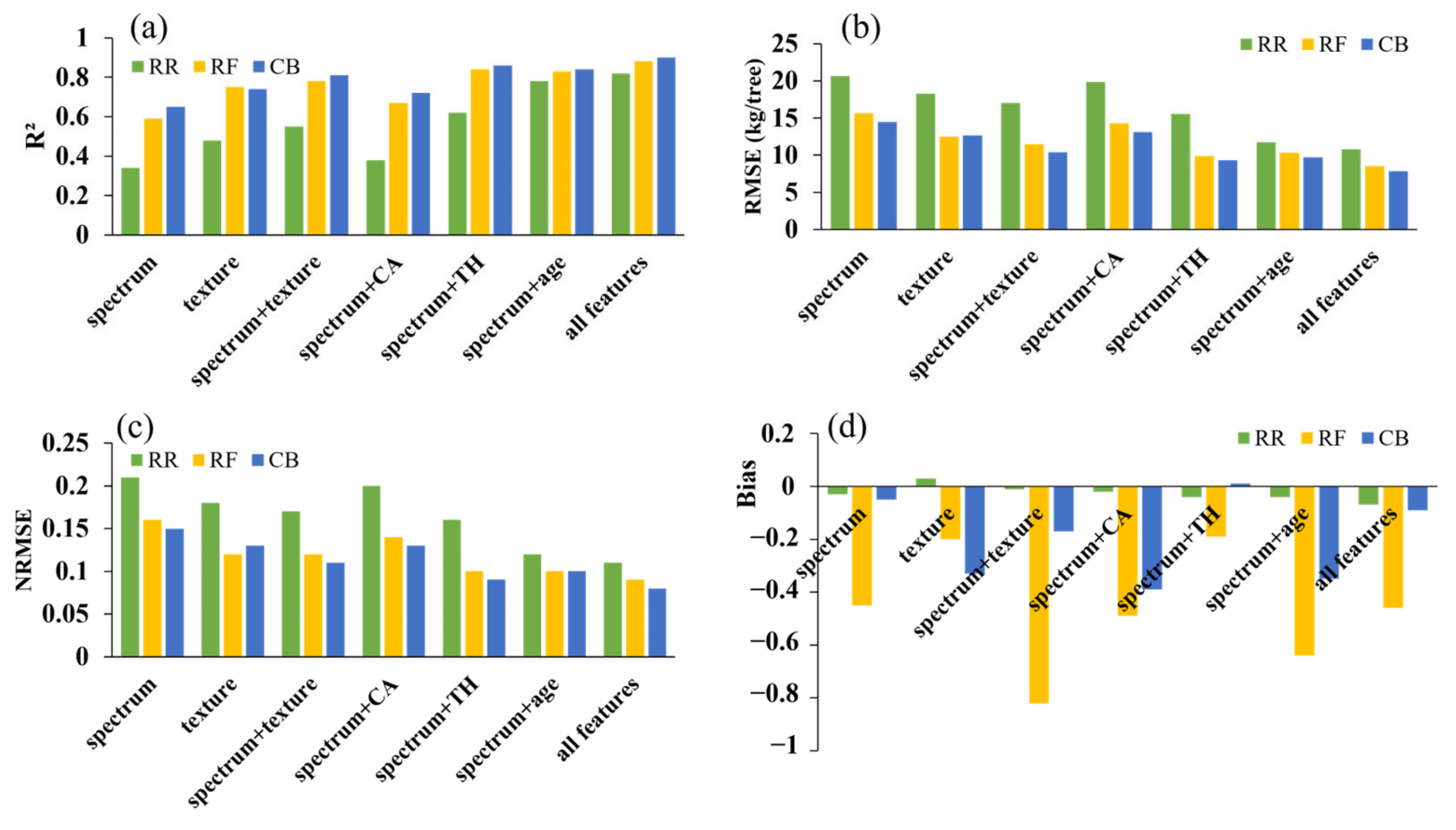
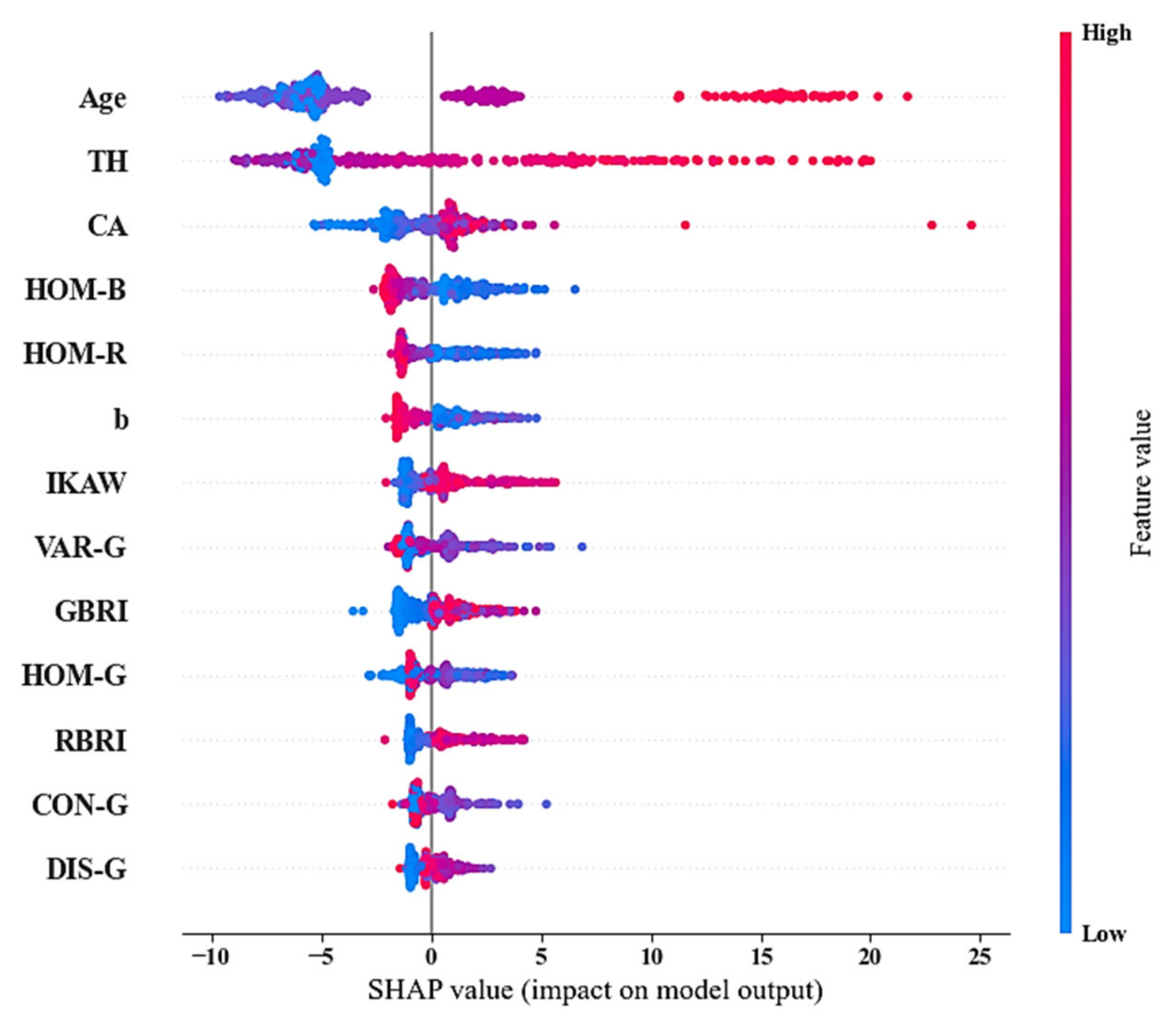
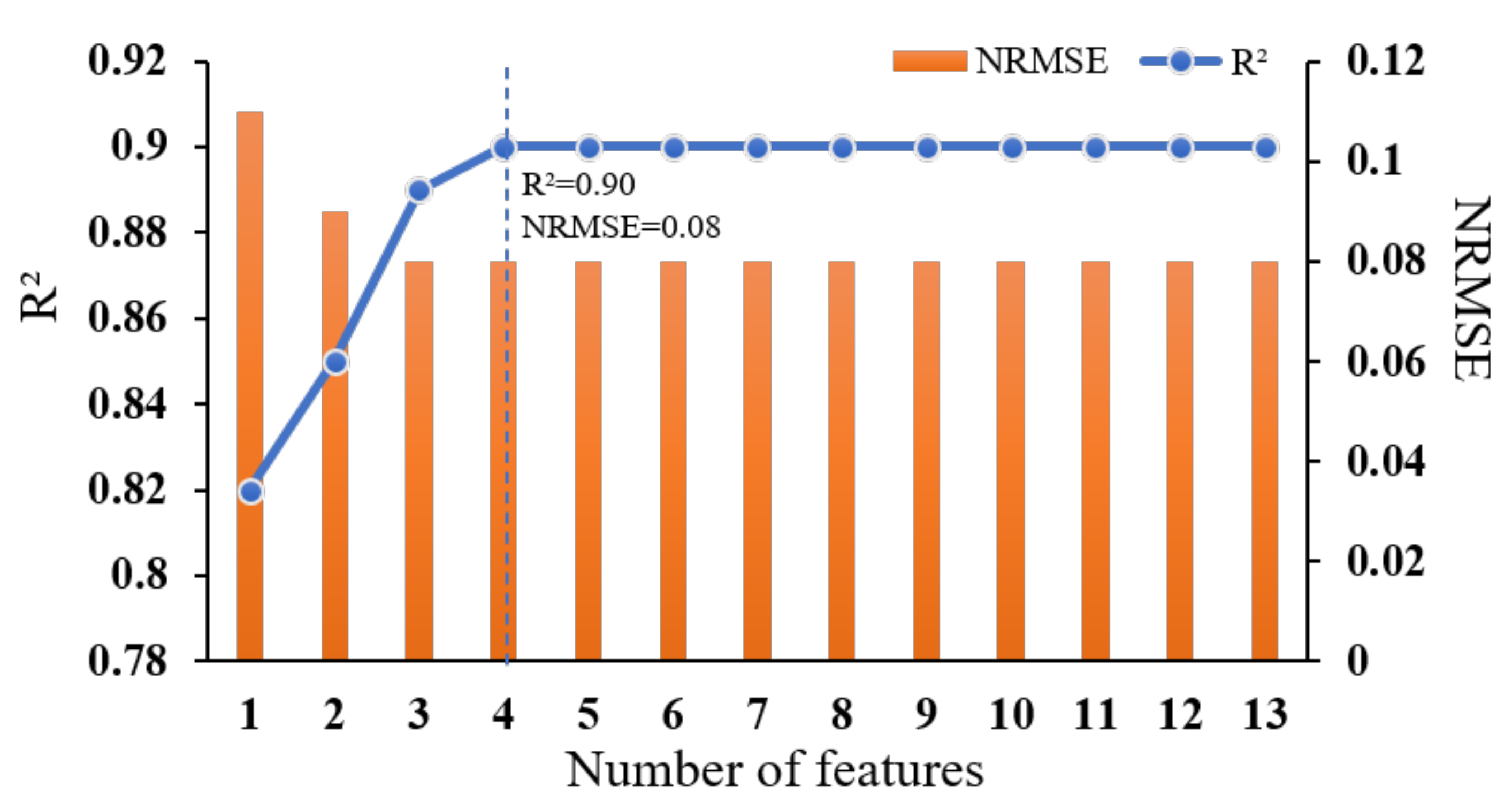
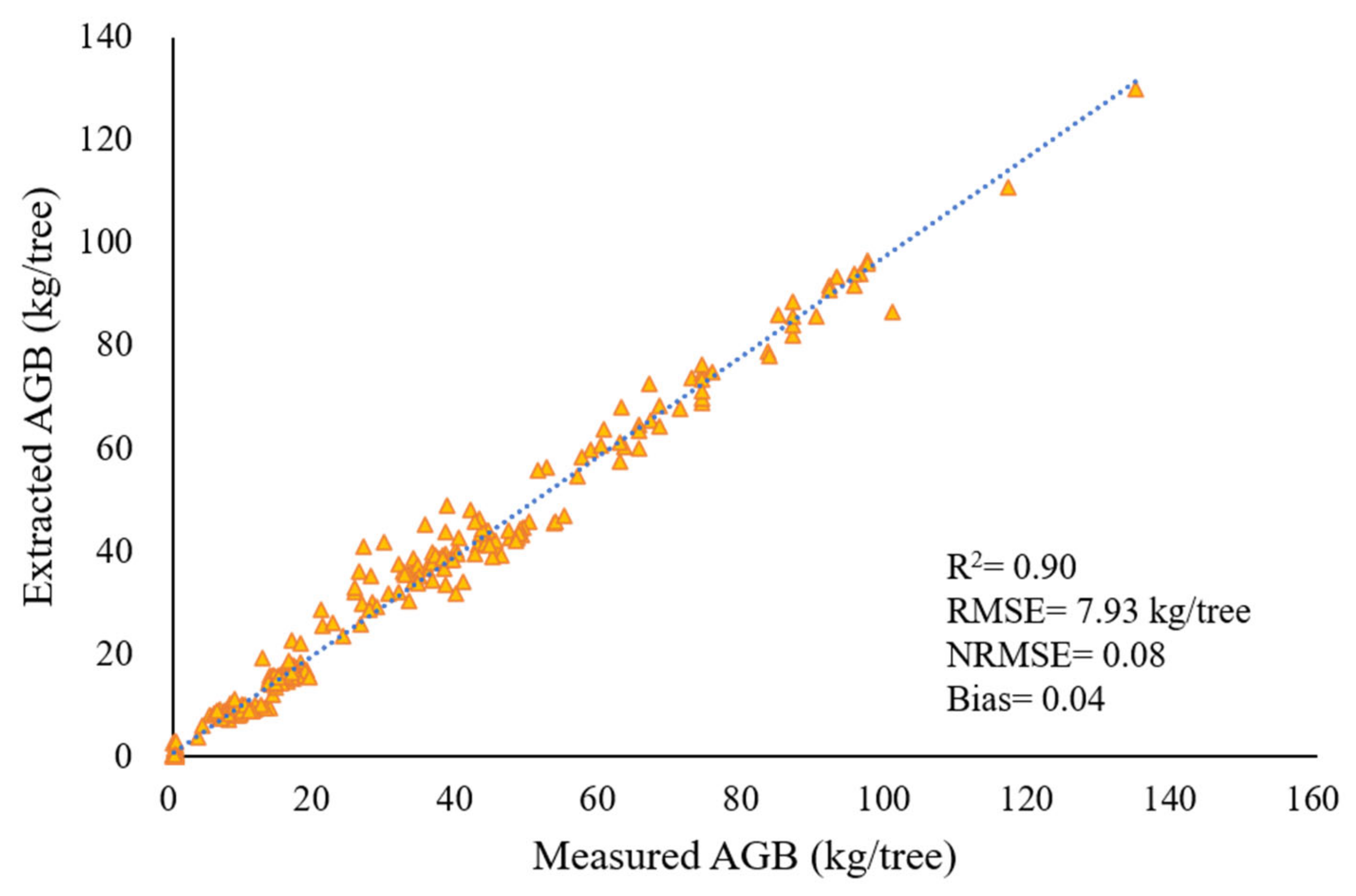
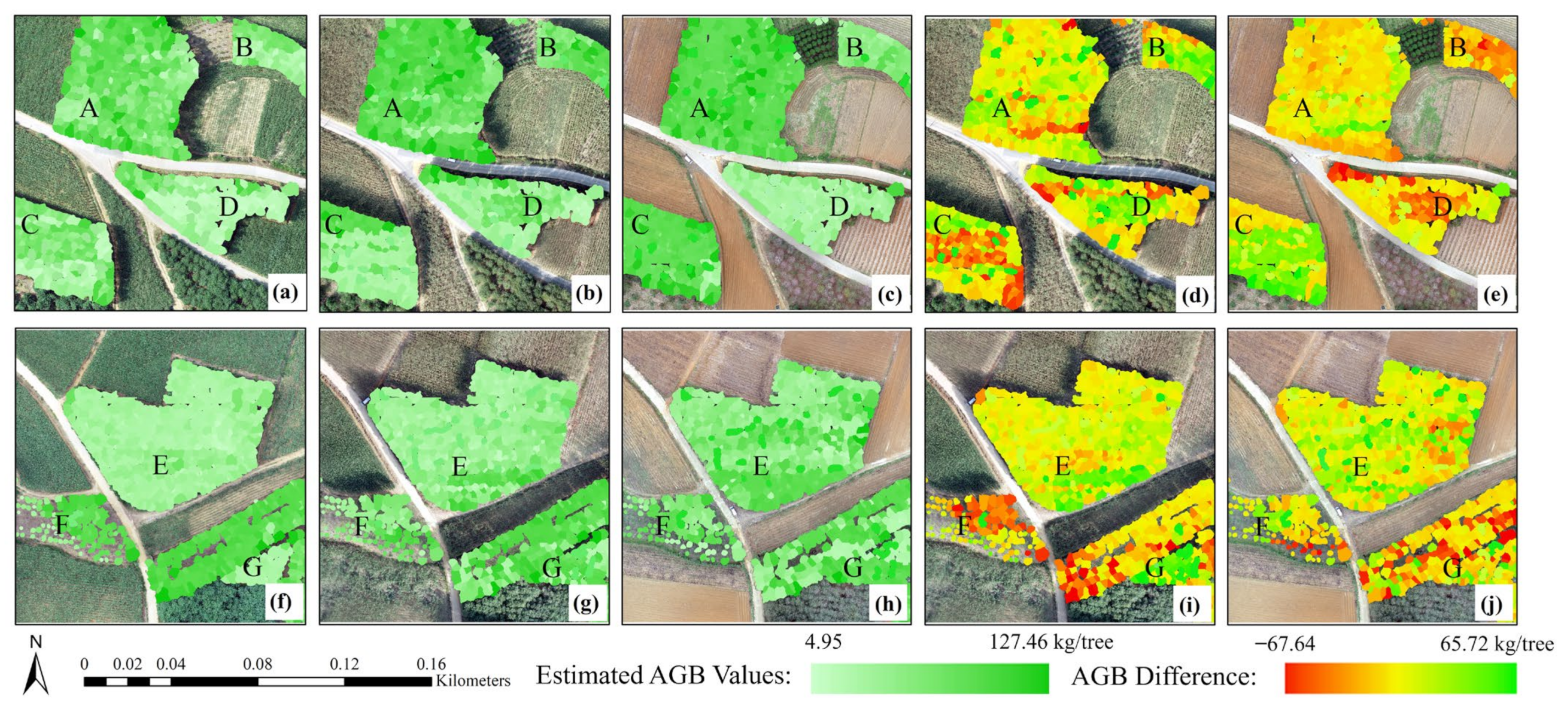
| Forest Age (Month) | Number | Average DBH (cm) | DBH SD (cm) | Average TH (m) | TH SD (m) |
|---|---|---|---|---|---|
| 1 | 85 | 2.38 | 0.21 | 1.59 | 0.35 |
| 11 | 52 | 6.03 | 0.59 | 8.93 | 0.44 |
| 15 | 85 | 7.68 | 0.20 | 10.42 | 0.33 |
| 22 | 70 | 10.44 | 1.16 | 13.06 | 0.83 |
| 36 | 57 | 13.17 | 1.59 | 15.84 | 1.26 |
| VI | Name | Formula | Reference |
|---|---|---|---|
| VARI | Visible Atmospherically Resistant Index | (g − r)/(g + r − b) | [36] |
| ExR | Excess Red Vegetation Index | 1.4r − g | [37] |
| ExB | Excess Blue Vegetation Index | 1.4b − g | [38] |
| ExG | Excess Green Vegetation Index | 2g − r − b | [38] |
| ExGR | Excess Green minus Excess Red Vegetation Index | ExG − ExR | [38] |
| WI | Woebbecke Index | (g − b)/(r − g) | [39] |
| IKAW | Kawashima Index | (r − b)/(r + b) | [40] |
| GLA | Green Leaf Algorithm | (2g – r − b)/(2g + r + b) | [41] |
| CIVE | Color Index of Vegetation | 0.441r − 0.881g + 0.385b + 18.78745 | [38] |
| COM | Combination | 0.25ExG + 0.3ExGR + 0.33CIVE + 0.12VEG | [38] |
| GRRI | Green–Red Ratio Index | G/R | [40] |
| GBRI | Green–Blue Ratio Index | G/B | [40] |
| RBRI | Red–Blue Ratio Index | R/B | [40] |
| INT | Color Intensity Index | (R + G + B)/3 | [40] |
| VEG | Vegetative | g/r0.667 × b0.333 | [42] |
| MGRVI | Modified Green–Red Vegetation Index | (g2 − r2)/(g2 + r2) | [43] |
| Textural Features | Formula |
|---|---|
| Mean (MEA) | |
| Variance (VAR) | |
| Homogeneity (HOM) | |
| Contrast (CON) | |
| Dissimilarity (DIS) | |
| Entropy (ENT) | |
| Second Moment (SEM) | |
| Correlation (COR) |
| Forest Age (Month) | Number | TP | FN | FP | R | P | F |
|---|---|---|---|---|---|---|---|
| 1 | 85 | 85 | 0 | 0 | 1 | 1 | 1 |
| 11 | 25 | 20 | 2 | 3 | 0.91 | 0.87 | 0.89 |
| 15 | 91 | 86 | 0 | 5 | 1 | 0.95 | 0.97 |
| 22 | 79 | 69 | 0 | 10 | 1 | 0.87 | 0.93 |
| 36 | 20 | 16 | 0 | 4 | 1 | 0.80 | 0.89 |
Disclaimer/Publisher’s Note: The statements, opinions and data contained in all publications are solely those of the individual author(s) and contributor(s) and not of MDPI and/or the editor(s). MDPI and/or the editor(s) disclaim responsibility for any injury to people or property resulting from any ideas, methods, instructions or products referred to in the content. |
© 2023 by the authors. Licensee MDPI, Basel, Switzerland. This article is an open access article distributed under the terms and conditions of the Creative Commons Attribution (CC BY) license (https://creativecommons.org/licenses/by/4.0/).
Share and Cite
Liu, Y.; Lei, P.; You, Q.; Tang, X.; Lai, X.; Chen, J.; You, H. Individual Tree Aboveground Biomass Estimation Based on UAV Stereo Images in a Eucalyptus Plantation. Forests 2023, 14, 1748. https://doi.org/10.3390/f14091748
Liu Y, Lei P, You Q, Tang X, Lai X, Chen J, You H. Individual Tree Aboveground Biomass Estimation Based on UAV Stereo Images in a Eucalyptus Plantation. Forests. 2023; 14(9):1748. https://doi.org/10.3390/f14091748
Chicago/Turabian StyleLiu, Yao, Peng Lei, Qixu You, Xu Tang, Xin Lai, Jianjun Chen, and Haotian You. 2023. "Individual Tree Aboveground Biomass Estimation Based on UAV Stereo Images in a Eucalyptus Plantation" Forests 14, no. 9: 1748. https://doi.org/10.3390/f14091748
APA StyleLiu, Y., Lei, P., You, Q., Tang, X., Lai, X., Chen, J., & You, H. (2023). Individual Tree Aboveground Biomass Estimation Based on UAV Stereo Images in a Eucalyptus Plantation. Forests, 14(9), 1748. https://doi.org/10.3390/f14091748






